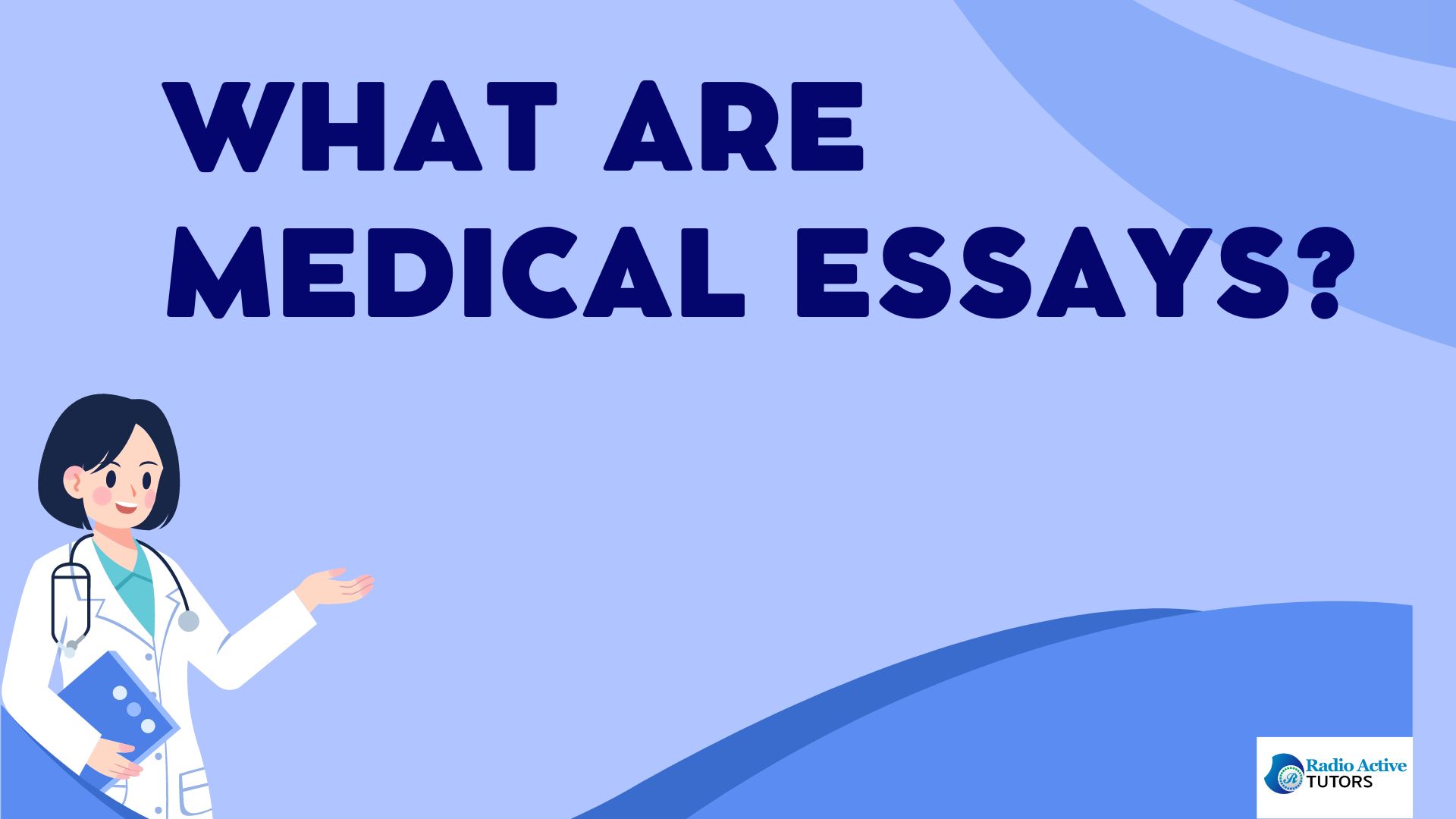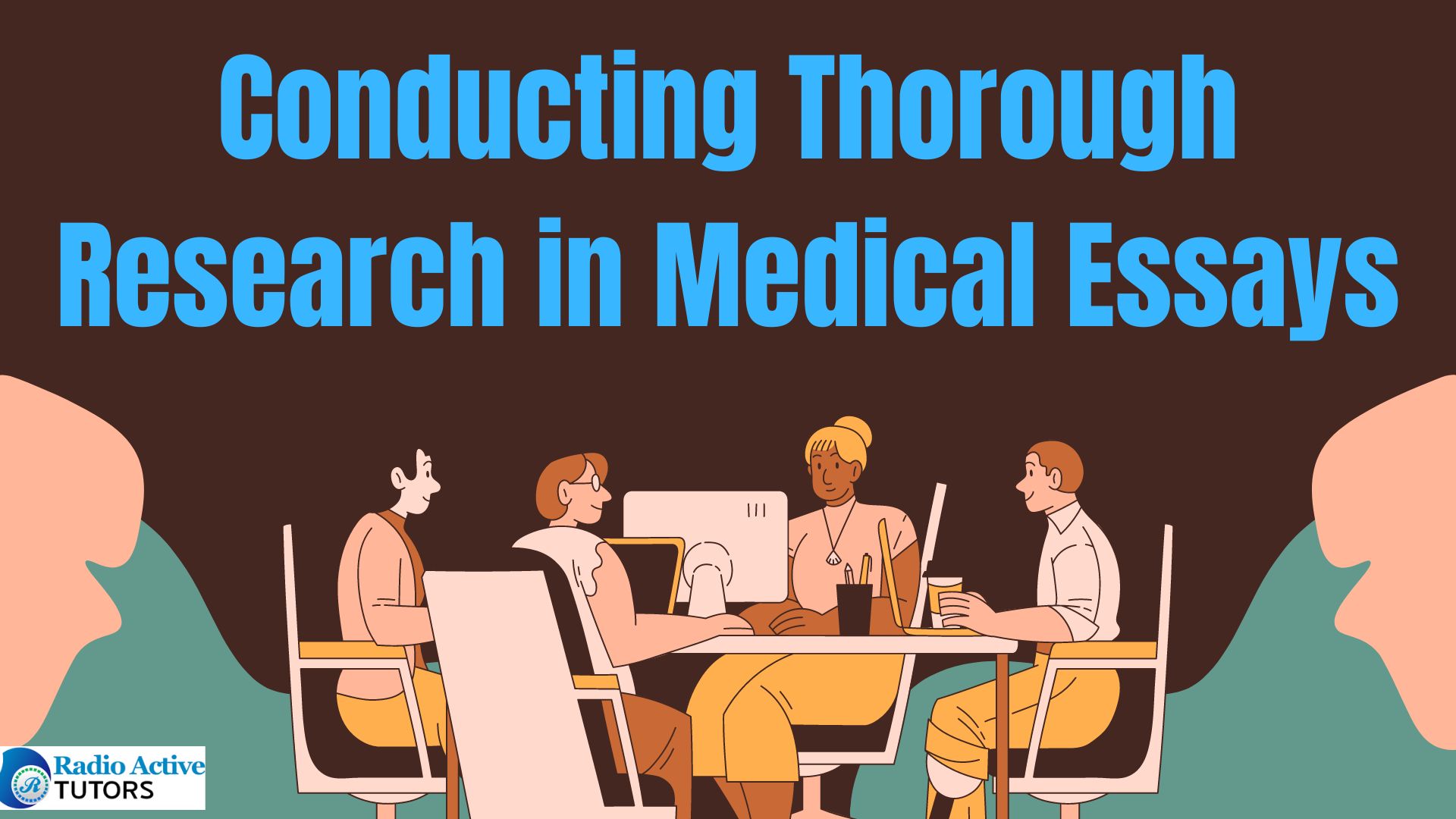Table of Contents
I. Introduction to Medical Essays
II. Selecting a Compelling Topic for Medical Essays
III. Conducting Thorough Research in Medical Essays
IV. Structuring Your Medical Essay
V. Writing the Introduction of Medical Essays
VI. Developing the Body Paragraphs in Medical Essays
VII. Crafting the Conclusion in Medical Essays
VIII. Referencing and Citations in Medical Essays
IX. Editing and Proofreading
X. Frequently Asked Questions (FAQs)
I. Introduction to Medical Essays
A. Definition and Significance

Medical essays are structured pieces of writing that explore various aspects of health, disease, medical treatments, and advancements in medical science. They serve multiple purposes, from educating the public and informing healthcare professionals to contributing to academic discourse and influencing medical policy. The significance of medical essays lies in their ability to synthesize complex medical information into accessible narratives that can enhance understanding, support evidence-based practice, and drive innovation. By clearly defining the topic and establishing its relevance, medical essays not only engage readers but also provide a foundation for thoughtful discussion and critical analysis within the medical community.
B. Purpose of Medical Essays
The primary purpose of medical essays is to communicate complex medical information in a clear and accessible manner, bridging the gap between scientific research and practical application. These essays aim to educate readers, whether they are medical professionals, students, or the general public, on various medical topics, including advancements in treatments, public health issues, and clinical case studies. Additionally, medical essays serve to stimulate critical thinking and discussion, encouraging the exploration of new ideas and perspectives within the medical field. By meticulously analyzing and presenting data, medical essays contribute to the ongoing development of medical knowledge, promote evidence-based practices, and support informed decision-making in healthcare.
C. Overview of Key Elements
A well-crafted medical essay comprises several key elements that collectively ensure the effectiveness and clarity of the communication. Firstly, a strong thesis statement anchors the essay, providing a clear focus and guiding the direction of the content. The introduction sets the stage by outlining the essay’s objectives and relevance. Body paragraphs delve into specific arguments, backed by rigorous research and data analysis, to build a coherent and persuasive narrative. Proper referencing and citations are crucial for maintaining academic integrity and credibility. Visual aids such as charts and tables enhance comprehension by presenting complex information succinctly. The conclusion synthesizes the main points, reiterates the thesis in light of the evidence presented, and often suggests areas for further research. Lastly, meticulous editing and proofreading ensure the essay is polished and free of errors. These elements, when integrated seamlessly, create a compelling and informative medical essay that effectively communicates its message to the intended audience.
II. Selecting a Compelling Topic for Medical Essays
A. Identifying Areas of Interest
Choosing a compelling topic for a medical essay begins with identifying areas of personal interest and professional relevance. This initial step allows writers to engage passionately with their subject matter, which is crucial for sustaining motivation and producing quality work. Considering current issues and trends in medical research and practice helps in selecting topics that are not only timely but also impactful. Evaluating the potential significance of a topic involves assessing its relevance to healthcare advancements, patient outcomes, public health policies, or ethical considerations. Additionally, exploring interdisciplinary perspectives can lead to innovative approaches and insightful discussions within the field. By carefully evaluating these factors, writers can ensure that their chosen topic not only captivates readers but also contributes meaningfully to the broader discourse in medical literature.
B. Evaluating Relevance and Impact
When selecting a topic for a medical essay, it is crucial to evaluate its relevance and potential impact within the context of current medical research and healthcare practices. A relevant topic addresses pressing issues or gaps in knowledge that are significant to the medical community and society at large. It should contribute to advancing understanding, improving patient care, or informing policy decisions. Assessing the impact involves considering how the chosen topic could potentially influence medical practices, patient outcomes, or public health outcomes. This evaluation ensures that the essay not only engages readers but also makes a meaningful contribution to the field of medicine by addressing pertinent challenges or exploring innovative solutions. By prioritizing relevance and impact, writers can effectively communicate the importance of their chosen topic and inspire further exploration and discussion within the medical community.
C. Consulting Current Research and Trends
Consulting current research and staying updated with emerging trends are essential steps in selecting a compelling topic for a medical essay. This process involves exploring recent studies, literature reviews, and clinical trials relevant to the chosen area of interest. By examining the latest findings and discussions in medical journals, conferences, and reputable online databases, writers can identify gaps in knowledge, controversial issues, or areas where new insights have emerged. Additionally, understanding current trends in medical research helps writers anticipate future developments and ensures that their essay addresses contemporary challenges or innovations in healthcare. By grounding their topic selection in current research, writers can provide readers with up-to-date information and contribute meaningfully to ongoing conversations within the medical community.
III. Conducting Thorough Research in Medical Essays

A. Utilizing Reliable Sources
Crafting a strong medical essay hinges on a foundation of reliable sources. To ensure the accuracy and credibility of your research, prioritize scholarly databases, government health websites (.gov), and reputable medical institutions. Seek out peer-reviewed journals, published by medical professionals, and avoid information with commercial bias. Remember, currency is key in medicine, so prioritize recent publications for the most up-to-date findings. By following these essential tips, you’ll be well on your way to a well-informed and impactful medical essays.
B. Reviewing Scientific Journals and Publications
In-depth analysis of scientific journals is paramount for robust medical essays. Develop a critical eye when reviewing publications. Evaluate the authors’ credentials, ensuring they are experts in the field. Scrutinize the methodology, assessing if the research design is sound and unbiased. Pay close attention to the results section, analyzing data and drawing your own conclusions alongside those presented. Look for limitations acknowledged by the authors, as no study is perfect. By actively dissecting scientific journals, you’ll glean the most valuable insights to strengthen medical essays.
C. Incorporating Statistical Data
Numbers speak volumes in the world of medicine. Strong medical essays effectively integrate statistical data to bolster arguments and paint a clear picture. Seek out data from credible sources like government health agencies or reputable clinical trials. Present the statistics clearly, using tables, graphs, or figures where appropriate. Always explain the data in context, highlighting its significance to your essay’s topic. Don’t shy away from addressing limitations in the data, demonstrating a well-rounded understanding. By incorporating well-chosen statistics, you’ll elevate your essay’s persuasiveness and showcase the essay’s grounding in concrete evidence.
IV. Structuring Your Medical Essay
A. Crafting a Strong Thesis Statement
The cornerstone of well-structured medical essays is a powerful thesis statement. This single sentence acts as a roadmap, outlining your central argument and guiding the essay’s direction. A strong thesis in medicine should be specific, taking a clear stance on a particular issue or treatment. It should be debatable, presenting a claim that can be supported by evidence and invites critical analysis. Additionally, it should be concise, effectively conveying your main point without unnecessary fluff. By crafting a strong thesis statement, you’ll ensure medical essays has a clear focus and effectively communicates your unique perspective on the medical topic at hand.
B. Organizing the Essay Logically
Structuring medical essays for logical flow is paramount for reader comprehension. Typically, medical essays follows the tried-and-true Introduction-Body-Conclusion (IBC) format. The introduction sets the stage, introducing the topic and culminating in your well-crafted thesis statement. The body paragraphs delve deeper, each tackling a single key point that supports your thesis. Organize these body paragraphs logically, often chronologically, by mechanism of action, or by comparing and contrasting different approaches. Transitions between paragraphs ensure smooth flow, guiding the reader through your argument. Finally, the conclusion summarizes your main points, reiterates the significance of your thesis, and potentially leaves the reader with a thought-provoking question or future direction for research. By adhering to this logical structure, medical essays will be clear, concise, and impactful.
C. Using Headings and Subheadings Effectively
Don’t underestimate the power of headings and subheadings in structuring medical essays. These act as signposts, guiding your reader through the intricate landscape of your research. Effective headings are concise and informative, accurately reflecting the content of the following section. Utilize a clear hierarchy, with main headings demarcating major topics and subheadings further detailing sub-points. This structure allows readers to quickly grasp the essay’s organization and locate specific information they seek. By strategically using headings and subheadings, you enhance the readability and professionalism of medical essays.
V. Writing the Introduction of Medical Essays
A. Capturing the Reader’s Attention
In the fiercely competitive world of medical research, grabbing a reader’s attention from the outset is crucial. Craft a captivating introduction that piques their interest and compels them to delve deeper. Consider opening with a thought-provoking question, a surprising statistic highlighting the issue’s prevalence, or a compelling case study that personalizes the medical topic. Maintain a professional tone, yet weave in a touch of intrigue to leave the reader wanting more. By starting strong, you’ll set the stage for well-received medical essays with lasting impact.
B. Providing Background Information
A strong introduction in medical essays shouldn’t jump straight into your specific research. Instead, establish context by providing essential background information. This could involve defining a key medical term, outlining the history of a treatment approach, or highlighting the prevalence of a particular disease. Keep the information concise and relevant to your thesis, ensuring it sets the stage for a deeper exploration in the body paragraphs. Providing this background equips the reader with the necessary knowledge to fully grasp your argument and appreciate the significance of your research.
C. Presenting the Thesis Statement

The crowning jewel of a well-crafted introduction in medical essays is the thesis statement. This pivotal sentence serves as a beacon, guiding the reader and focusing entire essasy. Ideally, your thesis should be positioned near the end of the introduction. It should be clear, concise, and debatable. Don’t simply announce your topic; take a clear stance on a specific issue or treatment within the broader medical field. Briefly mention the key points you’ll explore in the body paragraphs to demonstrate how they contribute to your central argument. By presenting a strong thesis statement, you establish a roadmap for essays and ensure the reader understands the specific contribution your research makes to the medical conversation.
D. Outlining the Essay Structure
In a medical essay’s introduction, outlining the essay structure subtly guides the reader through your research journey. This doesn’t involve a rigid, point-by-point breakdown, but rather a strategic foreshadowing of the key points you’ll address. Briefly mention the main arguments or evidence you’ll present in the body paragraphs, without going into detail. This roadmap piques the reader’s interest while assuring them they’ll receive a comprehensive analysis. By subtly outlining the medical essays structure, you create anticipation for the deeper dive into your research and establish a logical flow for the entire piece.
VI. Developing the Body Paragraphs in Medical Essays
A. Integrating Research Findings
The body paragraphs are where your medical essay truly shines. Here’s where you seamlessly integrate your research findings to support your thesis. Each paragraph should focus on a single key point that strengthens your central argument. Don’t just list findings; weave them into a cohesive narrative. Start with a strong topic sentence that clearly connects back to your thesis. Present research results, citing credible sources and using in-text citations. Explain the significance of the findings and how they bolster your point. Consider including counterarguments or limitations of the research to demonstrate a well-rounded understanding. Finally, conclude each body paragraph by summarizing its main point and smoothly transitioning to the next key aspect of your research. By integrating findings effectively, your body paragraphs become a powerful argument for your thesis.
B. Analyzing and Interpreting Data
Data analysis is the lifeblood of a strong medical essay’s body paragraphs. Move beyond simply reporting statistics; delve into their meaning and implications. Explain the methodology behind the data to establish its credibility. Use clear and concise language, avoiding overly technical jargon. Visual aids like graphs, charts, or tables can effectively showcase complex data. Analyze trends and patterns within the data, highlighting their connection to your thesis. Don’t shy away from discussing limitations or potential biases in the data, demonstrating a critical and balanced approach. Ultimately, your analysis should transform raw data into clear insights that illuminate your argument and solidify the foundation of your medical essay.
C. Maintaining Clarity and Precision
The body paragraphs of your medical essay should be bastions of clarity and precision. Strive for language that is clear, concise, and easy for the reader to understand. Avoid overly technical jargon or ambiguous terms that might leave them confused. Define any essential medical terms you introduce to ensure everyone is on the same page. Maintain a formal tone, using active voice and proper grammar. Sentence structure should vary to keep the reader engaged. By prioritizing clarity and precision, you ensure your arguments resonate with the reader and the complex medical information is presented in a way that is both accurate and accessible.
VII. Crafting the Conclusion in Medical Essays
A. Summarizing Main Points

Crafting a compelling conclusion in a medical essay hinges on effectively summarizing your main points. Briefly revisit the key arguments presented in the body paragraphs, reminding the reader of the journey you’ve taken together. Don’t simply repeat everything verbatim – rephrase and synthesize the main ideas in a concise and impactful way. Reconnect the summarized points back to your central thesis, solidifying how your research supports your initial claim. You can also consider the broader implications of your findings, highlighting their potential impact on the medical field or future research directions. By providing a clear and concise summary, your conclusion leaves a lasting impression and underscores the significance of your medical essay’s contribution to the topic at hand.
B. Restating the Thesis in Light of Evidence
In the conclusion of your medical essay, don’t simply restate your thesis verbatim. Instead, revisit it in light of the evidence presented. Has your understanding of the topic evolved through your research? Refine the thesis to reflect the insights gleaned from the data and analysis. Emphasize how the evidence you meticulously explored has solidified, nuanced, or even challenged your initial stance. This demonstrates a thoughtful exploration and strengthens the impact of your research. Ultimately, your restated thesis should be a powerful culmination, showcasing the depth of your investigation and the significance of your findings within the broader medical conversation.
C. Highlighting the Significance of Findings
Don’t let your impactful research findings languish in the body paragraphs. The conclusion is your prime opportunity to illuminate their significance. Explain how your findings contribute to a deeper understanding of the medical topic. Do they offer support for existing treatment approaches, or perhaps pave the way for novel interventions? Highlight the potential real-world implications of your research, emphasizing how it might benefit patients, healthcare professionals, or the general public. Acknowledge any limitations of your study, but also suggest avenues for future research to build upon your findings. By showcasing the broader significance of your research, you leave the reader with a sense of the essay’s lasting impact and its potential to influence the future of medicine.
VIII. Referencing and Citations in Medical Essays
A. Importance of Proper Citations
In the realm of medical essays, proper citations are the cornerstone of credibility and academic integrity. They serve a dual purpose: referencing and crediting your sources. Citations within the text, often indicated by numbers or author names in parentheses, allow readers to pinpoint the exact source of information. This empowers them to delve deeper if desired. The reference list at the end of your essay then provides complete bibliographic details of each source you’ve used. Following a recognized citation style, like APA or AMA, ensures consistency and facilitates easy retrieval of the source material. By upholding proper citation practices, you demonstrate meticulous research, avoid plagiarism accusations, and ultimately bolster the trustworthiness of your medical essay.
B. Common Citation Styles (APA, MLA, Chicago, etc.)
While several citation styles exist across academia, medical essays often utilize specific formats to ensure clarity and consistency within the scientific community. The two most prominent styles are AMA (American Medical Association) and Vancouver (also known as Uniform Requirements for Manuscripts Submitted to Biomedical Journals). AMA style emphasizes a numbered in-text citation system with a corresponding reference list featuring complete bibliographic details. Vancouver, on the other hand, utilizes a name-and-year system within the text, directing readers to a reference list ordered alphabetically by the first author’s last name. Familiarize yourself with the specific requirements of your chosen style, consulting resources like style manuals or online guides. Following a recognized medical citation style demonstrates professionalism and allows for seamless exchange of information within the medical field.
C. Creating a Reference List
While several citation styles exist across academia, medical essays often utilize specific formats to ensure clarity and consistency within the scientific community. The two most prominent styles are AMA (American Medical Association) and Vancouver (also known as Uniform Requirements for Manuscripts Submitted to Biomedical Journals). AMA style emphasizes a numbered in-text citation system with a corresponding reference list featuring complete bibliographic details. Vancouver, on the other hand, utilizes a name-and-year system within the text, directing readers to a reference list ordered alphabetically by the first author’s last name. Familiarize yourself with the specific requirements of your chosen style, consulting resources like style manuals or online guides. Following a recognized medical citation style demonstrates professionalism and allows for seamless exchange of information within the medical field.
D. Avoiding Plagiarism
Maintaining academic integrity is paramount in medical essays, and proper citation practices are your shield against plagiarism. Don’t fall into the trap of simply copying information or rephrasing sentences without proper attribution. Always cite any ideas, data, or even specific wording you borrow from a source, even if it’s paraphrased. Utilize in-text citations to pinpoint the exact source of the information within your essay. By meticulously referencing your sources and avoiding the temptation to present someone else’s work as your own, you demonstrate respect for intellectual property and uphold the ethical standards expected in medical research and writing.
IX. Editing and Proofreading
A. Importance of Reviewing Your Work
The final step in crafting a stellar medical essay is meticulous reviewing and revision. Don’t underestimate the power of editing and proofreading in polishing your work. Start by taking a step back from your writing and allowing yourself some fresh perspective. Then, delve into editing, ensuring your arguments flow logically and your thesis remains the central focus. Scrutinize your essay for grammatical errors, typos, or inconsistencies in formatting. Proofreading with a keen eye catches these minor yet crucial mistakes that can detract from the professionalism of your essay. Consider having a trusted peer review your work as well, offering a fresh set of eyes to identify areas for improvement. By dedicating time to thorough editing and proofreading, you ensure your medical essay is not only informative but also error-free and impactful.
B. Techniques for Effective Proofreading
Mastering the art of proofreading is crucial for crafting a polished medical essay. Here, meticulous attention to detail is key. Employ a multi-pronged approach. Print a copy and proofread on paper for a different perspective. Read your essay aloud; this can expose awkward phrasing or inconsistencies that might slip by visually. Focus on one type of error at a time, whether it’s grammar, punctuation, or spelling. Utilize online grammar checkers, but remember they’re not foolproof – always double-check their suggestions. Pay particular attention to medical terminology, ensuring accuracy and proper capitalization. By implementing these techniques, you’ll transform your proofreading process from a chore to a confidence-boosting final step, guaranteeing your medical essay shines with clarity and professionalism.
C. Seeking Feedback from Peers and Mentors

In the realm of medical essays, seeking feedback from peers and mentors can elevate your work to new heights. Consider a trusted classmate or colleague who can offer a fresh perspective on your arguments and identify areas for improvement in logic or clarity. Additionally, professors or advisors can provide invaluable insights, especially if they possess expertise in the specific medical field you’re exploring. Don’t be afraid to ask them to review your thesis statement, the flow of your arguments, or the overall persuasiveness of your essay. Feedback from mentors can also help identify potential biases or gaps in your research that you might have missed. By incorporating the constructive criticism of peers and mentors, you can refine your medical essay, ensuring it not only meets academic standards but also resonates with a wider audience within the medical field.
XII. Frequently Asked Questions (FAQs)
A. How do I choose a relevant topic for my medical essay?
B. What sources are considered reliable for medical research in medical essays?
C. How do I properly cite sources in my medical essay?
D. What are some tips for editing and proofreading in medical essays?
E. How can I ensure my medical essay is ethical?
F. What are common mistakes to avoid in medical essay writing?
G. How do I incorporate visual aids effectively?
H. How do I tailor my essay for different audiences?
I. What tools can help with medical essay writing?
J. How do I stay updated with the latest medical research for medical essays?
